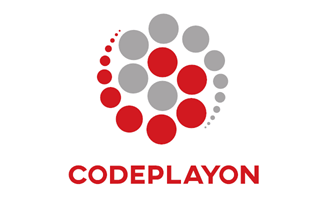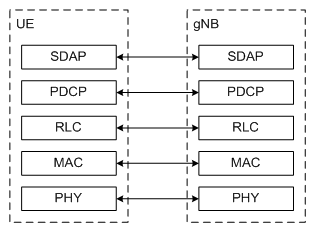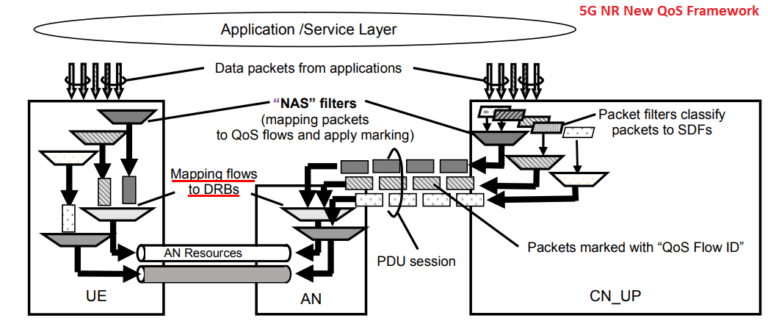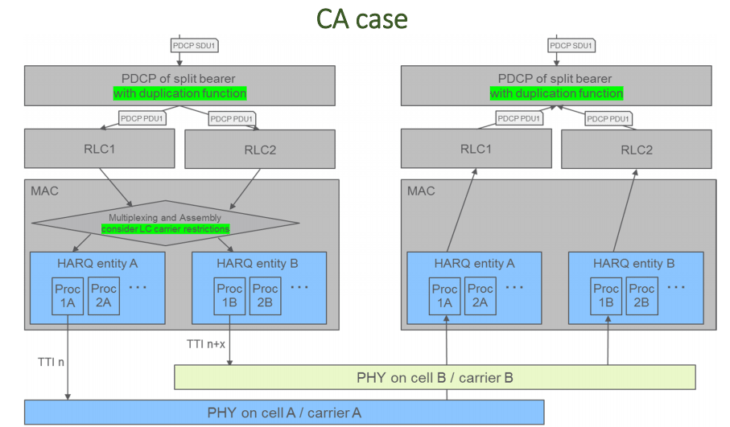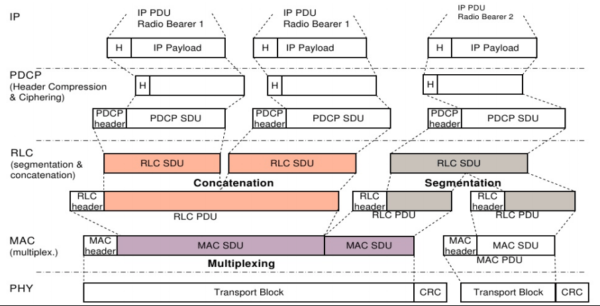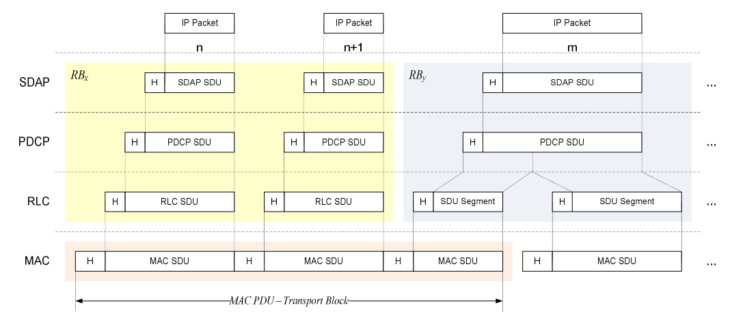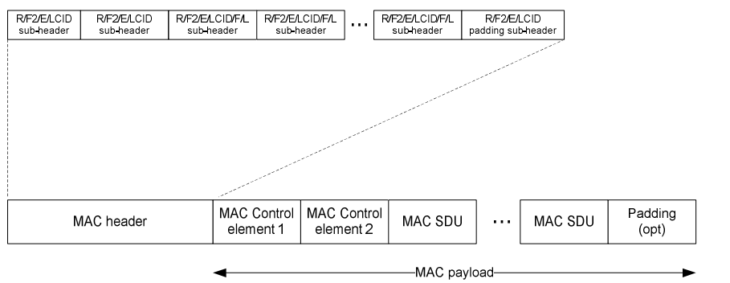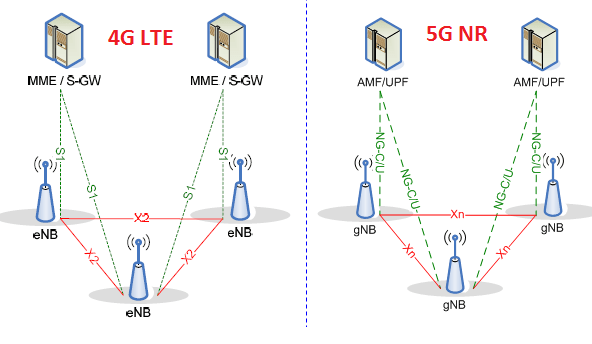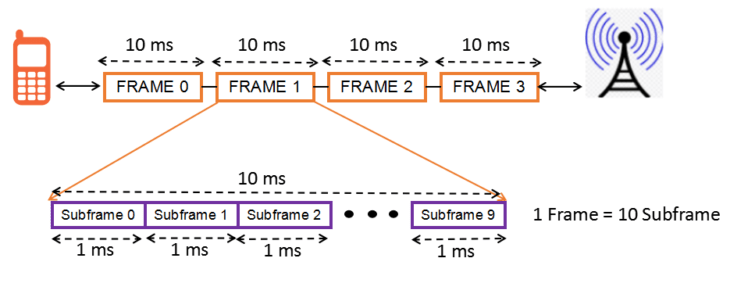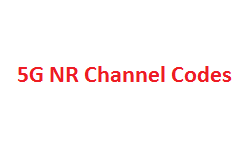5G NR User Plane Protocol
5G NR User Plane Protocol, What’s new Over LTE in 5G NR
3GPP has released specification 38.300 V1 this month about NR and NG-RAN Overall Description: Stage 2, This standard comes with the detailed descriptions about 5G NR network and Protocol architecture. In this post, we have come with the detailed information about the User plane and providing information what new we can expect/Enhancements proposed from NR to meet the requirements of eMBB (enhanced Mobile Broadband), Massive IoT (Internet of things) and URLLC (Ultra-reliable Low latency communication).
NR User Plane Protocol Stack is shown in below figures,
Figure #1 User Plane Protocol Stack
When we closely see both the protocol stack we could see many similarities between LTE protocol stack and 5G-NR protocol stack because LTE protocol stack is being taken as the base line for the development of 5G-NR.
5G-NR User contains Phy, MAC, RLC, and PDCP same as LTE and has introduced a new layer named as SDAP (Service Data Adaptation Protocol).
Protocol Layer Function and Description
SDAP (Service Data Adaptation Protocol) Protocol Functions :
The main services and functions of SDAP include:
- Mapping between a QoS flow and a data radio bearer (Due to new QoS framework)
- Marking QoS flow ID (QFI) in both DL and UL packets ( DL: due to reflective QoS and UL: due to new QoS framework)
- A single protocol entity of SDAP is configured for each individual PDU session, except for DC where two entities can be configured
In the uplink, the NG-RAN may control the mapping of QoS Flows to DRB in two different ways:
- Reflective mapping: for each DRB, the UE monitors the QoS flow ID(s) of the downlink packets and applies the same mapping in the uplink; that is, for a DRB, the UE maps the uplink packets belonging to the QoS flows(s) corresponding to the QoS flow ID(s) and PDU Session observed in the downlink packets for that DRB. To enable this reflective mapping, the NG-RAN marks downlink packets over Uu with QoS flow ID.
- Explicit Configuration: besides the reflective mapping, the NG-RAN may configure by RRC an uplink “QoS Flow to DRB mapping”.
PDCP (Packet Data Convergence Protocol) Layer Functions:
The main services and functions of the PDCP sublayer for the user plane include:
- Sequence Numbering
- Header compression and decompression: ROHC only
- Transfer of user data
- Reordering and Duplicate detection (if order delivery to layers above PDCP is required)
- PDCP PDU routing (in case of split bearers)
- Retransmission of PDCP SDUs
- Ciphering and Deciphering
- PDCP SDU discard
- PDCP re-establishment and data recovery for RLC AM
- Duplication of PDCP PDUs
PDCP Out-of-Order Deciphering Drawback in LTE
- In-sequence delivery from RLC layer (i.e. reordering in RLC) might incur high latency due to deciphering
Enhancement in NR
- Complete PDCP PDUs can be delivered out-of-order from RLC to PDCP. RLC delivers PDCP PDUs to PDCP after the PDU reassembling
- PDCP reordering is always enabled if in sequence delivery to layers above PDCP is needed (i.e. even in non-DC case)
RLC Rx window operation in NR
- RLC Rx entity needs to keep track of each packet in the window to determine if any of them has been completed and delivered to PDCP
Duplication of PDCP PDUs
- RLC retransmission (ARQ) is not assumed to be used in 5G NR to meet the strict user plane latency requirements of URLLC applications
How it will work for 5G-NR
- Duplication applies in case of multi-connectivity and carrier aggregation (CA).
- In case of CA, duplication for more than one logical channel is used for Carrier Aggregation so that the duplicated PDCP PDUs are sent over different carriers.
- PDCP duplication solution for CA requires only one MAC entity.
- Logical channel mapping restrictions need to be introduced to handle duplicates in within one MAC entity (CA).
RLC (Radio Link Control ) Layer Functions:
The main services and functions of the RLC sublayer depend on the transmission mode and include:
- Transfer of upper layer PDUs
- Sequence numbering independent of the one in PDCP
- Error Correction through ARQ
- Segmentation and re-segmentation
- Reassembly of SDU
- RLC SDU discard
- RLC re-establishment
Note: no concatenation and no reordering
Why No Concatenation
To meet Extreme latency requirement in 5G
- For URLLC the target for user plane latency should be 0.5ms for UL, and 0.5ms for DL
- For eMBB, the target for user plane latency should be 4ms for UL, and 4ms for DL.
- RAN1 intends to reduce the delay from the end of the reception of the DCI (UL grant) to the beginning of the transmission of the corresponding UL transport block to 1-2 OFDM symbol durations
Limitation in LTE: In order to perform TB filling, RLC and MAC PDUs are generated after reception of UL grant
Removing RLC concatenation enables the preprocessing procedure of both RLC and MAC layer
MAC (Media Access Control) Layer Functions
The main services and functions of the MAC sub layer include:
- Mapping between logical channels and transport channels
- Multiplexing/demultiplexing of MAC SDUs belonging to one or different logical channels into/from transport blocks (TB) delivered to/from the physical layer on transport channels
- Scheduling Information Reporting
- Error correction through HARQ
- Priority handling between UEs by means of dynamic scheduling
- Priority handling between logical channels of one UE by means of logical channel prioritization
- Padding
MAC New PDU Format
- Drawback in LTET MAC PDU format is that it does not facilitate MAC/PHY parallel processing
Enhancement in NR
- MAC sub-headers are placed immediately in front of the corresponding MAC SDUs, MAC CEs, or padding. The possibility to parse the MAC PDU from the back is not precluded.
- UL MAC CE(s) is placed after all the MAC SDUs. For DL the placement will be deterministic (i.e. it should not be up to the network to decide). FFS if we have the same behavior for both or for DL the MAC CE is placed at the front.
LCP Enhancement
The motivation behind LCP enhancement is Multiple numerologies/TTI durations are supported and different numerologies/TTI durations may be suitable for different kinds of traffic
Enhancement in NR
- A single logical channel can be mapped to one or more numerology/TTI duration
- For the purpose of LCP, the MAC entity learns the TTI duration/numerology from the PHY layer. FFS on the details of how it is signaled. This can be done explicitly (i.e. some field in the DCI) or implicitly (e.g. the TTI duration of the UL transmission is the same as the DL transmission of the UL grant)
- LCP takes into account the mapping of the logical channel to one or more numerology/TTI duration. This includes Priority, PBR concept is used in NR as a baseline and Logical channel priority is configured per UE as a baseline. FFS is anything needs to be done to treat logical channels differently
SR/BSR Enhancement
Motivation for SR/BSR enhancement is that it should at least distinguish the “numerology/TTI type” of the logical channel that triggered the SR/BSR
Enhancement in NR
- Multiple-bit SR or Single-bit SR with multiple SR configurations
- The existing LTE BSR framework is used as the baseline for NR BSR framework. Further enhancements at least related to numerologies and granularity are in further discussion
• Numerologies: Extend the number of LCGs to link an LCG to a specific numerology
• Granularity: increasing the number of bits in the BS field, increasing the number of LCGs, reporting BSR per logical channel
HARQ Enhancement
In LTE Performance of HARQ degraded due to large transport block size
Enhancement in NR
- Code Block Group (CBG)-based transmission with single/multi-bit HARQ-ACK feedback is
supported - The UE is semi-statically configured by RRC signaling to enable CBG-based retransmission.
- The above semi-static configuration to enable CBG-based retransmission is separate for DL
and UL
- Asynchronous and adaptive UL HARQ is supported at least for eMBB
- Flexible timing
• Timing between DL assignment and corresponding DL data transmission is indicated by a field in the DCI from a set of values
• Timing between UL assignment and corresponding UL data transmission is indicated by a field in the DCI from a set of values
• Timing between DL data reception and corresponding acknowledgment is indicated by a field in the DCI from a set of values and this set of values is configured by higher layer
• NR UE supports a set of minimum HARQ processing time, this shall include Delay between DL data reception timing to the corresponding HARQ-ACK transmission timing, Delay between UL grant reception timing to the corresponding UL data transmission timing and NR UE is required to indicate its capability of minimum HARQ processing time to gNB
Also Read :-
